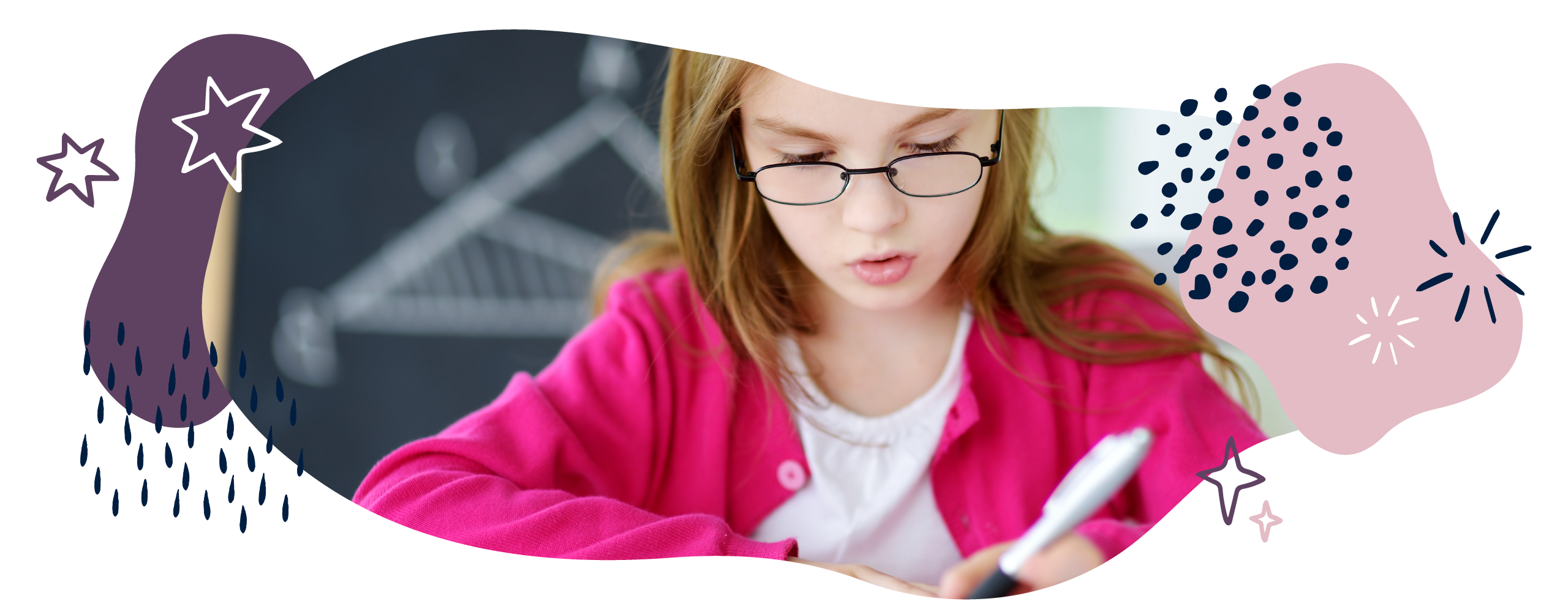

Number & place value in Year 5 (age 9–10)
In Year 5, your child will be reading, writing, and comparing numbers up to 1,000,000. They will round large numbers, interpret negative numbers in lots of contexts, and learn Roman numerals up to 1000 (M).
The key words for this section are number and place value .
What your child will learn
Take a look at the National Curriculum expectations for number and place value in Year 5 (ages 9–10):
Read, write, and compare numbers up to at least 1,000,000
Place value is the basis of our number system and allows us to represent all our numbers with just the digits 0–9. Your child will understand that the position of the digit in a number tells us the value of the digit.
Your child will know the value of each digit in numbers up to at least a million. They will be able to order and compare numbers using their understanding of place value.

Note that the children will use the vocabulary ones and not units when talking about place value.
Count in powers of 10 from any number up to 1,000,000
Your child will be expected to count forwards and backwards in powers of 10 from any number up to a million.
Count forwards in steps of 10 ² (100) from 25,760: 25,860, 25,960, 26,060, and so on. Count backwards in steps of 10 ³ (1000) from 8151: 7151, 6151, 5151, and so on.
Interpret and use negative numbers
Your child will interpret negative numbers in real-world contexts. For example, they might learn about negative numbers using temperature or money.
Your child will also count forwards and backwards with positive and negative whole numbers, including counting through 0. For example:
Count backwards from 6 to -3: 6, 5, 4, 3, 2, 1, 0, -1, -2, -3.
Round numbers to the nearest 10, 100, 1000, 10,000, and 100,000
Your child will round numbers up to a million up or down to the nearest 10, 100, 1000, 10,000 and 100,000.
537,129 rounded to the nearest 1000: 537,000. 145,674 rounded to the nearest 10,000: 150,000. 832,541 rounded to the nearest 100,000: 800,000.
Solve increasingly complex number problems
Children will solve problems involving:
- Negative numbers
- Roman numerals.
Their knowledge of place value will be very useful for this. They will use physical objects, drawings, diagrams, and mathematical symbols to visualise problems.
Read Roman numerals to 1000 (M)
Your child will be able to read Roman numerals from 1 (I) to 1000 (M). They should be able to recognise years written in Roman numerals.
1 = I 5 = V 10 = X 50 = L 100 = C 500 = D 1000 = M 1995 = MCMXCV 2019 = MMXIX
How to help at home
There are lots of ways you can help your child to understand number and place value . Here are just a few ideas:
1. Use place value charts
Place value charts can be a great way to help your child represent numbers and understand how the number system works. These charts will help your child to read, write, and compare numbers, as well as to understand how zero is used as a placeholder.

2. Use place value knowledge
When comparing numbers up to 1,000,000, your child should look at the digit with the largest value first. For example, if your child is comparing the numbers 232,765 and 233,276, they would first need to look at the digit with the largest value. In this example, as the hundred thousands and ten thousands digits are the same, we need to look at the thousands digit:
232,765 has 2 thousands, and 233,276 has 3 thousands, so 232,765 is less than 233,276.
Encourage your child to use their knowledge of number and place value to identify patterns when calculating. For example, if you know 4 + 3 = 7, then you also know 0.4 + 0.3 = 0.7. This is because each of the numbers in the calculation is now ten times smaller, so the total will be ten times smaller.
Give your child a simple addition calculation using one-digit numbers such as 5 + 4 = 9. How many related calculations can they record using this fact? For example:
15 + 4 = 19 5 + 14 = 19 50 + 40 = 90 500 + 400 = 900 0.5 + 0.4 = 0.9 + = … and so on.
Activity: Place value pandemonium
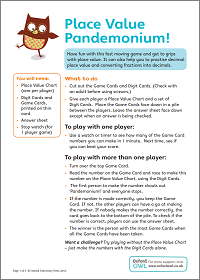
3. Explore negative numbers
Chatting about the numbers we see around us will help your child use numbers in all parts of their daily lives. Point out negative numbers in the real world, such as temperatures on the weather forecast. Vertical number lines, such as those seen on thermometers, can help your child grasp the concept of negative numbers.
Activity: Negative numbers
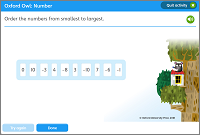
4. Make estimates
Being able to make accurate estimates is a valuable skill we use in everyday life. When calculating, encourage your child to use their rounding skills to estimate the answer before calculating precisely. This will help them to check if their answer seems reasonable.
If you are out shopping and you have picked up a few items, ask your child to estimate the total cost of the items. They will need to round the cost of each item to find the estimated total. For example, if you bought items costing £3.82, 82p, £4.10, and £2.45, your child could round each of these items to the nearest pound:
£3.82 to £4 82p to £1 £4.10 to £4 £2.45 to £2
Your child could then add the rounded amounts of £4, £1, £4, and £2 to find the estimated total of £11. When they calculate precisely and come to £11.19, they can feel fairly confident that their calculation was correct.
5. Play Roman numerals bingo
Your child will be expected to be able to read Roman numerals from 1 to 1000. Point out Roman numerals in the modern world. For example, Roman numerals are used on older buildings to show when they were built, or at the end of a film to show the year it was made.
Why not play Roman numeral bingo with your child? Create bingo boards using pieces of A4 paper. Choose and write down six different Roman numerals between 1 and 100 on each piece of paper (one piece of paper per player). One player chooses a number between 1 and 100 and announces it. If a player has that number shown in Roman numerals, they can cover that number. The first player to cover all numbers is the winner.
Here are the Roman numerals up to 1000, with some examples of years written in Roman numerals:
1 = I 5 = V 10 = X 50 = L 100 = C 500 = D 1000 = M 1995 = MCMXCV 2019 = MMXIX
- Age 3–4 (Early Years)
- Age 4–5 (Reception)
- Age 5–6 (Year 1)
- Age 6–7 (Year 2)
- Age 7–8 (Year 3)
- Age 8–9 (Year 4)
- Age 9–10 (Year 5)
- Age 10–11 (Year 6)
- Year 1 (age 5–6)
- Year 2 (age 6–7)
- Year 3 (age 7–8)
- Year 4 (age 8–9)
- Year 5 (age 9–10)
- Year 6 (age 10–11)
- Help with times tables
- Ratio & proportion
- Learning to tell the time
- Numicon parent guide
- MyMaths parent guide
- Maths activity books
Popular searches in the last week:
Maths year 5 autumn place value.
Teach a selection of units to meet the needs of your class.
Place value in 5-digit numbers (suggested as 3 days)
Lesson planning.

- Mastery Activity with Answers
In-depth Investigation: Space Distances from nrich.maths.org.

- Practice Worksheets with Answers

- Mental/Oral Starters
- Starter Resources
- Unit Resources
- Extra Support

Teacher Tips

- Common Misconceptions
TAs & Tutors / Home Learning
With TA/Tutor
These materials are for a TA or Tutor to use with a small group of children or one child. They support the learning in class in this unit. Notes are provided for teacher and TA/Tutor.
- TA/Tutor Activities
Back to Lockdown?
Home Learning packs are not being prepared for this Block of learning.
Place 5-digit numbers on a line; round (suggested as 2 days)

In-depth Investigation: Adapt Nice or Nasty (Game 3) from nrich.maths.org.

Place 6-digit numbers on a line; round (suggested as 3 days)

In-depth Investigation: Adapt Nice or Nasty (Game 5, Nasty Version) from nrich.maths.org.

Deepen understanding of 6-digit numbers (suggested as 2 days)

In-depth Investigation: Activity Set A from ncetm.org.uk

Hamilton’s problem-solving investigations are 'low floor, high ceiling' activities that give all children opportunities to develop mastery and mathematical meta-skills. Explore a set for a whole year group.
Extra Support worksheets come with guidance for a teacher or TA working with small groups. They can make a significant difference to children working below ARE. Extra support is linked to individual objectives-based units, but you can also explore a set for a whole year.
Procedural fluency is fundamental to numeracy, and Hamilton's practice worksheets are carefully differentiated for children working toward Age Related Expectations (ARE), at ARE and at greater depth. Practice is linked to individual objectives-based units, but you can also explore sets of worksheets for the whole year.
This site uses cookies to give you the most relevant information. Learn more
Log in or sign up to get access to this resource
School subscription, reduce teacher workload.
From £155 (+ VAT) per year. Access to all key stages for multiple users.
Individual Subscription
For inspirational teaching.
Just £45 (£37.50 + VAT) per year to get access to all resources.
Early Career Teacher
Develop your teaching.
Just £33 (£27.50 + VAT) to get access to all resources for 2 years.
Taster Account
100s of resources.
Register to access all free resources.
Already subscribed?
Log in to get access.

Or search by topic
Number and algebra
- The Number System and Place Value
- Calculations and Numerical Methods
- Fractions, Decimals, Percentages, Ratio and Proportion
- Properties of Numbers
- Patterns, Sequences and Structure
- Algebraic expressions, equations and formulae
- Coordinates, Functions and Graphs
Geometry and measure
- Angles, Polygons, and Geometrical Proof
- 3D Geometry, Shape and Space
- Measuring and calculating with units
- Transformations and constructions
- Pythagoras and Trigonometry
- Vectors and Matrices
Probability and statistics
- Handling, Processing and Representing Data
- Probability
Working mathematically
- Thinking mathematically
- Mathematical mindsets
- Cross-curricular contexts
- Physical and digital manipulatives

For younger learners
- Early Years Foundation Stage
Advanced mathematics
- Decision Mathematics and Combinatorics
- Advanced Probability and Statistics
Place Value KS2
This collection is one of our Primary Curriculum collections - tasks that are grouped by topic.
Number Match
A task which depends on members of the group noticing the needs of others and responding.
Dicey Addition
Who said that adding couldn't be fun?
The Thousands Game
Each child in Class 3 took four numbers out of the bag. Who had made the highest even number?
Take Three Numbers
What happens when you add three numbers together? Will your answer be odd or even? How do you know?
Number Differences
Place the numbers from 1 to 9 in the squares below so that the difference between joined squares is odd. How many different ways can you do this?
Less Is More
Use your knowledge of place value to try to win this game. How will you maximise your score?
Round the Four Dice
This activity involves rounding four-digit numbers to the nearest thousand.
Can you put the numbers 1-5 in the V shape so that both 'arms' have the same total?
Round the Three Dice Live
What happens when you round these three-digit numbers to the nearest 100?
Four-digit Targets
You have two sets of the digits 0-9. Can you arrange these in the five boxes to make four-digit numbers as close to the target numbers as possible?
Coded Hundred Square
This 100 square jigsaw is written in code. It starts with 1 and ends with 100. Can you build it up?
Which Scripts?
There are six numbers written in five different scripts. Can you sort out which is which?
The Deca Tree
Find out what a Deca Tree is and then work out how many leaves there will be after the woodcutter has cut off a trunk, a branch, a twig and a leaf.
Dicey Operations in Line
Who said that adding, subtracting, multiplying and dividing couldn't be fun?
Reasoned Rounding
Four strategy dice games to consolidate pupils' understanding of rounding.
Nice or Nasty
There are nasty versions of this dice game but we'll start with the nice ones...
Number Lines in Disguise
Some of the numbers have fallen off Becky's number line. Can you figure out what they were?


- £ 0.00 0 items
Year 5 Problem Solving with Place Value Maths Challenge
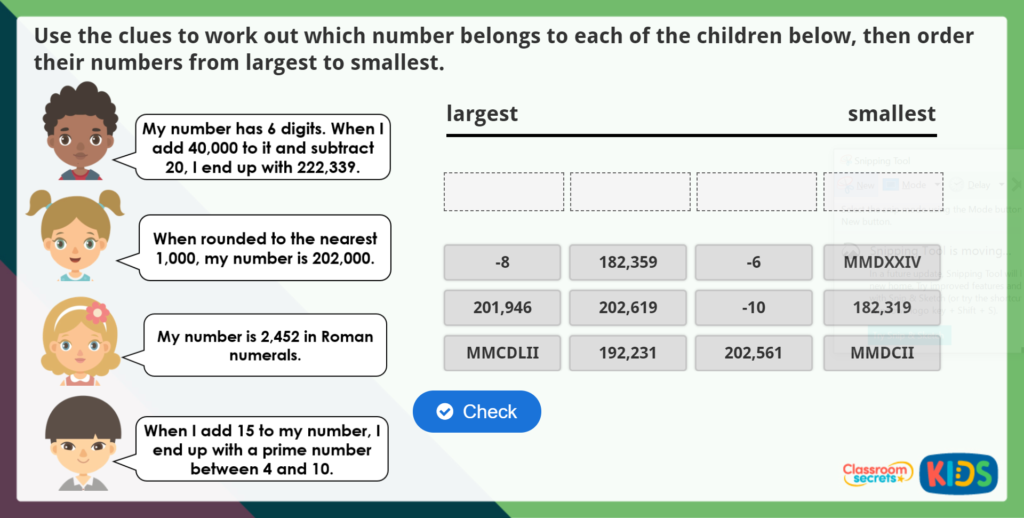
This Year 5 Problem Solving with Place Value Maths Challenge aims to secure your child’s understanding of place value while developing their problem solving skills. Children with use clues to work out which numbers the characters have created and then order them. The problem includes negative numbers, Roman numerals, and rounding.
If you would like to access additional resources which link to this maths challenge, you can purchase a subscription for only £5.31 per month on our sister site, Classroom Secrets .
Teacher Specific Information
This Year 5 Problem Solving with Place Value Maths Challenge checks pupils’ understanding of place value while aiming to develop their problem solving skills. Pupils will use clues to work out which numbers the characters have created and then order them. The problem includes negative numbers, Roman numerals, and rounding.
National Curriculum Objectives
Number – number and place value (5N1) Count forwards or backwards in steps of powers of 10 for any given number up to 1,000,000 (5N2) Read, write, order and compare numbers to at least 1,000,000 (5N3a) Determine the value of each digit in numbers up to 1,000,000 (5N3b) Read Roman numerals to 1,000 (M) and recognise years written in Roman numerals (5N4) Round any number up to 1,000,000 to the nearest 10, 100, 1,000, 10,000 and 100,000 (5N5) Interpret negative numbers in context, count forwards and backwards with positive and negative whole numbers, including through zero (5N6) Solve number problems and practical problems that involve 5N1 – 5N5
Have you visited our sister site yet?

Primary resources for teachers
Classroom Secrets provides high-quality, affordable teaching resources that children love, and teachers trust.

Stay in touch

01422 419608
Interested in getting weekly updates from us? Then sign up to our newsletter here!
Information

- Cookie Policy
- Privacy Settings
- Terms and Conditions
- End User License Agreement
Copyright: Classroom Secrets 2024
Company number: 8401067
VAT number: 248824574
Designed by Classroom Secrets
Bootstrap Modal Title
Bootstrap modal body text should be here.
- National Curriculum Resource Tool
Materials to support teachers and schools in embedding the National Curriculum
- Selected Results
Year 5: Number and Place Value
- read, write, order and compare numbers to at least 1 000 000 and determine the value of each digit
- count forwards or backwards in steps of powers of 10 for any given number up to 1 000 000
- interpret negative numbers in context, count forwards and backwards with positive and negative whole numbers, including through zero
- round any number up to 1 000 000 to the nearest 10, 100, 1000, 10 000 and 100 000
- solve number problems and practical problems that involve all of the above
- read Roman numerals to 1000 (M) and recognise years written in Roman numerals.
Year 5: Addition and Subtraction
- add and subtract whole numbers with more than 4 digits, including using formal written methods (columnar addition and subtraction)
- add and subtract numbers mentally with increasingly large numbers
- use rounding to check answers to calculations and determine, in the context of a problem, levels of accuracy
- solve addition and subtraction multi-step problems in contexts, deciding which operations and methods to use and why.
Year 5: Multiplication and Division
identify multiples and factors:
- identify multiples and factors, including finding all factor pairs of a number, and common factors of 2 numbers
- know and use the vocabulary of prime numbers, prime factors and composite (non-prime) numbers
- establish whether a number up to 100 is prime and recall prime numbers up to 19
- multiply numbers up to 4 digits by a one- or two-digit number using a formal written method, including long multiplication for two-digit numbers
- multiply and divide numbers mentally, drawing upon known facts
- divide numbers up to 4 digits by a one-digit number using the formal written method of short division and interpret remainders appropriately for the context
- multiply and divide whole numbers and those involving decimals by 10, 100 and 1,000
- recognise and use square numbers and cube numbers, and the notation for squared (²) and cubed (³)
- solve problems involving multiplication and division, including using their knowledge of factors and multiples, squares and cubes
- solve problems involving addition, subtraction, multiplication and division and a combination of these, including understanding the meaning of the equals sign
- solve problems involving multiplication and division, including scaling by simple fractions and problems involving simple rates
Year 5: Fractions (including decimals and percentages)
- compare and order fractions whose denominators are all multiples of the same number
- identify, name and write equivalent fractions of a given fraction, represented visually,including tenths and hundredths
- recognise mixed numbers and improper fractions and convert from one form to the other and write mathematical statements >1 as a mixed number[for example, 2 ⁄ 5 + 4 ⁄ 5 = 6 ⁄ 5 = 1 1 ⁄ 5 ]
- add and subtract fractions with the same denominator and denominators that are multiples of the same number
- multiply proper fractions and mixed numbers by whole numbers, supported by materials and diagrams
- read and write decimal numbers as fractions [for example, 0.71 = 71 ⁄ 100 ]
- recognise and use thousandths and relate them to tenths, hundredths and decimal equivalents
- round decimals with two decimal places to the nearest whole number and to one decimal place
- read, write, order and compare numbers with up to three decimal places
- solve problems involving number up to three decimal places
- recognise the per cent symbol (%) and understand that per cent relates to ‘number of parts per hundred’, and write percentages as a fraction with denominator 100, and as a decimal
- solve problems which require knowing percentage and decimal equivalents of 1 ⁄ 2 , 1 ⁄ 4 , 1 ⁄ 5 , 2 ⁄ 5 and those fractions with a denominator of a multiple of 10 or 25.
Year 5: Measurement
- convert between different units of metric measure (for example, kilometre and metre; centimetre and metre; centimetre and millimetre; gram and kilogram; litre and millilitre)
- understand and use approximate equivalences between metric units and common imperial units such as inches, pounds and pints
- measure and calculate the perimeter of composite rectilinear shapes in centimetres and metres
- calculate and compare the area of rectangles (including squares), and including using standard units, square centimetres (cm 2 ) and square metres (m 2 ) and estimate the area of irregular shapes
- estimate volume [for example, using 1 cm 3 blocks to build cuboids (including cubes)] and capacity [for example, using water]
- solve problems involving converting between units of time
- use all four operations to solve problems involving measure [for example, length, mass, volume, money] using decimal notation, including scaling.
Year 5: Geometry - properties of shapes
- identify 3-D shapes, including cubes and other cuboids, from 2-D representations
- know angles are measured in degrees: estimate and compare acute, obtuse and reflex angles
- draw given angles, and measure them in degrees (°)
- use the properties of rectangles to deduce related facts and find missing lengths and angles
- distinguish between regular and irregular polygons based on reasoning about equal sides and angles.
Year 5: Geometry - position and direction
- identify, describe and represent the position of a shape following a reflection or translation, using the appropriate language, and know that the shape has not changed.
Year 5: Statistics
- solve comparison, sum and difference problems using information presented in a line graph
- complete, read and interpret information in tables, including timetables.
Is there anything wrong with this page?
Subscribe to our newsletter
Place Value Questions
Place value questions with solutions are provided here for students to practice and enhance their skills. The place value of a digit in a number represents the position or place of that digit. For example, the place value of 2 in 726 is the tens place. Knowledge of place values will help kids to write numbers in words in both Indian and international systems.
Place value charts in Indian and International systems of numerals :
Learn more about Place Values .
Place Value Questions with Solution
Identifying the place value of a digit within a given number are taught to students of grades 1 to 5. These questions on place values will help them affirm their concept regarding place values and the numeral system.
Question 1: Find the place value of 5 for the following numbers:
Question 2: Find the place value of 2 and 7 for the following numbers:
(iii) 28467
Questions 3: Fill in the blanks:
(i) 20600 + ____ + 30 + 5 = 28635.
(ii) _____ + ____ + 86 = 4586.
(iii) 4000 + 3 + 400 + ____ = 4443.
(iv) 34589 = _____ + _____ + ____ + ______ +_____.
(i) 20600 + 8000 + 30 + 5 = 28635.
(ii) 4000 + 500 + 86 = 4586.
(iii) 4000 + 3 + 400 + 40 = 4443.
(iv) 34589 = 30,000 + 4000 + 500 + 80 + 9 .
- Numbers in Words
- Addition and Subtraction
- Number Lines
- Types of Numbers
Question 4: Identify the number which has 4 in tens place and 8 in thousands place. The digit in ones is half the sum of the digits in tens and thousands, and the digit in hundreds place is six less than the digit in ones place. Find the number.
Given, the number has 4 in the tens place and 8 in thousands place.
Digit in ones place = (8 + 4) ÷ 2 = 12/2 = 6
Digit in hundreds place = less than the digit in ones place = 6 – 6 = 0
Thus, the number is –
Question 5: Write following numbers in the place value chart in both Indian and International system:
(ii) 912597
(iii) 213709
(iv) 120986
Question 6: Find the sum and product of the place value and face value of 6 in the number 86245.
Place value of 6 = 6000
Face value of 6 = 6
6000 + 6 = 6006
6000 × 6 = 36000
Question 7: State ‘true’ or ‘false’ for the following statements:
(i) The place value and face value of any digit in ones place are the same.
(ii) Sum of the place values of 3 in the numbers 3986 and 9723 is 3030.
(iii) 300 + 60 + 5 = 356.
(iv) The face value of any digit is either less than or equal to the place value of the digit.
(v) The product of the place value of 4 in 4956 and the face value of 7 in 171 is 280000.
(i) The place value and face value of any digit in ones place are the same. (True)
(ii) Sum of the place values of 3 in the numbers 3986 and 9723 is 3030. (False)
(iii) 300 + 60 + 5 = 356. (False)
(iv) The face value of any digit is either less than or equal to the place value of the digit. (True)
(v) The product of the place value of 4 in 4956 and the face value of 7 in 171 is 280000. (False)
Question 8: Write the following numbers in words according to the Indian system:
(ii) 129644
(iii) 25456
(i) 94562 – Ninety-four thousand five hundred sixty-two.
(ii) 129644 – One lakh twenty-nine thousand six hundred forty-four.
(iii) 2545600 – Twenty-five lakhs forty-five thousand six hundred.
(v) 30764 – Thirty thousand seven hundred sixty-four.
Question 9: Write the following numbers in words according to the International system:
(ii) 5720964
(iii) 40972
(iv) 497114
(i) 34921 – Thirty-four thousand nine hundred twenty-one
(ii) 5720964 – Five million seven hundred twenty thousand nine hundred sixty-four
(iii) 40972 – Forty thousand nine hundred seventy-two
(iv) 497114 – Four hundred ninety-seven thousand one hundred fourteen
Question 10: Compare the following using ‘>’, ‘<’ or ‘=’:
(i) Place value of 3 in 3245 ____ Place value of 6 in 265
(ii) Places value of 5 in 456 ____ Place value of 2 in 234
(iii) Place value of 7 in 7980 ____ Place value of 5 in 5790
(iv) Place value of 4 in 234 ____ Face value of 9 in 494
(i) Place value of 3 in 3245 > Place value of 6 in 265
(ii) Places value of 5 in 456 < Place value of 2 in 234
(iii) Place value of 7 in 7980 > Place value of 5 in 5790
(iv) Place value of 4 in 234 = Face value of 4 in 495
Question 11: Write the following numbers in the place value charts:
(ii) 325.006
(iii) 0.976
Question 12: Fill in the blanks:
(i) 1 × 100 + 2 × 10 + 8 × 1 + 5 × 1/10 + 2 × 1/100 = _____.
(ii) 2 × 1000 + 28 × 10 + 1 × 1/10 + 1 × 1/100 = ________.
(iii) 0.008 + 1.07 + 0.5 = _______.
(iv) 300 + 4 + 45 + 0.0006 + 0.007 + 0.08 = ______.
(i) 1 × 100 + 2 × 10 + 8 × 1 + 5 × 1/10 + 2 × 1/100 = 128.52
(ii) 2 × 1000 + 28 × 10 + 1 × 1/10 + 1 × 1/100 = 2280.11
(iii) 0.008 + 1.07 + 0.5 = 1.578
(iv) 300 + 4 + 45 + 0.0006 + 0.007 + 0.08 = 349.0876
Practice Questions:
1. Find the place value of 6 for the following numbers:
(iii) 497612
2. The digits in the tens and the thousands place of a number are 3 and 9, respectively. The digit in the ones and the ten thousands places are 3 and 4 more than the digit in tens place. If the digit in the hundreds place is three less than the digit in ten thousands place, find the number.
3. Fill in the blanks:
(i) 3000 + 700 + _____ + 8 = 3758.
(ii) 200 + 9050 + 4 = ______.
(iii) 2000 + 0.009 + 12.23 + 300 = _____.
Keep visiting BYJU’S to get more such Maths lessons in a simple, concise and easy to understand way. Also, register at BYJU’S – The Learning App to get complete assistance for Maths preparation with video lessons, notes, tips and other study materials.
Leave a Comment Cancel reply
Your Mobile number and Email id will not be published. Required fields are marked *
Request OTP on Voice Call
Post My Comment
- Share Share
Register with BYJU'S & Download Free PDFs
Register with byju's & watch live videos.

- International
- Schools directory
- Resources Jobs Schools directory News Search
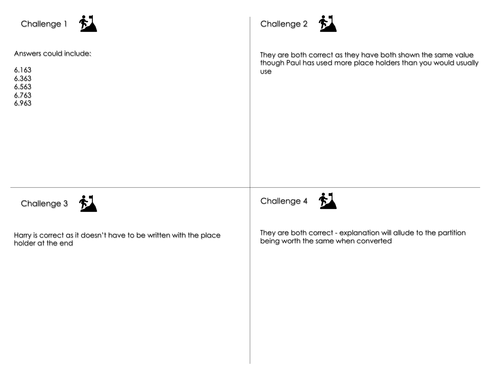
Decimal Place Value Challenge Questions
Subject: Mathematics
Age range: 7-11
Resource type: Worksheet/Activity
Last updated
3 November 2020
- Share through email
- Share through twitter
- Share through linkedin
- Share through facebook
- Share through pinterest

Four problem solving and reasoning style questions linked to decimal place value that are appropriate for Year 5 or 6. The answers are also included.
Creative Commons "Sharealike"
Your rating is required to reflect your happiness.
It's good to leave some feedback.
Something went wrong, please try again later.
This resource hasn't been reviewed yet
To ensure quality for our reviews, only customers who have downloaded this resource can review it
Report this resource to let us know if it violates our terms and conditions. Our customer service team will review your report and will be in touch.
Not quite what you were looking for? Search by keyword to find the right resource:

IMAGES
VIDEO
COMMENTS
Year 5/6 place value puzzles (reasoning/problem solving) Subject: Mathematics. Age range: 7-11. Resource type: Worksheet/Activity. Sophie Bartlett. ... 5 years ago. report. 5. Thank you for this. I saw it on Twitter ... (Company No 02017289) with its registered office at Building 3, St Paul's Place, Norfolk Street, Sheffield, S1 2JE ...
This pack of Maths PowerPoint activities will help your year 5 students master number and place value. With six different interactive PowerPoint activities and challenge cards on number and place value rounding, roman number calculations, negative numbers, and counting in powers of 10 - these activities will guarantee classroom engagement and effective learning.
Year 1 Year 2 Year 3 Year 4 Year 5 Year 6 count to and across 100, forwards and backwards, beginning with 0 or 1, or from any given number count backwards through zero to include negative ... Number and Place Value with Reasoning PROBLEM SOLVING use place value and number facts to solve problems solve number problems and practical problems ...
Year 5 Place Value Number Problems Maths Mastery Activities PowerPoint. ... Fluency, Reasoning and Problem Solving Year 5 Number and Place Value. How does this resource excite and engage children's learning? This PowerPoint provides a range of maths mastery activities based around the Year 5 objective "solve number problems and practical problems".
Here are just a few ideas: 1. Use place value charts. Place value charts can be a great way to help your child represent numbers and understand how the number system works. These charts will help your child to read, write, and compare numbers, as well as to understand how zero is used as a placeholder. For example, 210,421 could be represented ...
Practice is linked to individual objectives-based units, but you can also explore sets of worksheets for the whole year. Each unit in this Flexible Maths Block covers a set of Year 5 Place Value related skills and concepts. Unit 1: Place value in 5-digit numbers. Unit 2: Place 5-digit numbers on a line; round. Unit 3: Place 6-digit numbers on a ...
Find out how to count backwards from zero and order negative numbers. Understand place value and learn how to order numbers up to 100,000. Year 5 KS2 Maths Place value learning resources for ...
Our 100 More 100 Less Robots Worksheet is suitable for use either as a classroom task or homework activity. Next, take a look at our Year 5 Number and Practical Problems Resources. Use this set of NUMBER challenge cards to reinforce your teaching on TOPIC and test your students' knowledge. Great as an opening or finishing activity.
Age 7 to 11. Challenge Level. Place the numbers from 1 to 9 in the squares below so that the difference between joined squares is odd. How many different ways can you do this?
Year 5 Diving into Mastery: Step 13 Round within 100 000 Teaching Pack. 4.9 (9 Reviews) Year 5 Number and Place Value Rounding Maths Mastery PowerPoint. 4.0 (3 Reviews) Year 5 Number and Place Value Counting in Powers of 10 Maths Mastery PowerPoint. 4.5 (4 Reviews) Year 5 Diving into Mastery: Step 2 Numbers to 10 000 Teaching Pack.
Word Problems Year 5 Place Value. Help your pupils apply their understanding of place value to an unfamiliar context using these worded problems. 11 questions to develop reasoning and problem solving skills. This worksheet contains 10 place value questions of ascending difficulty plus one challenge question. An answer sheet is included.
Differentiated maths resources for Autumn Block 1 (Place Value) in small steps for KS2 children in Year 5. Each small step contains a range of resources including a teaching PowerPoint, varied fluency worksheets, reasoning and problem solving worksheets, homework or extension worksheets, discussion problems for collaborative learning, interactive games and a learning video clip.
Problem Solving with Place Value. I designed this problem-solving lesson to deepen students’ understanding of place value to connect it to other aspects of mathematics, including listing permutations, odd and even numbers and money. By linking to these topics, the questions are challenging yet remain accessible to students in key stage 3 ...
Year 5 Number and Place Value Roman Numerals Maths Mastery Challenge Cards. 3.0 (1 review) Year 5 Diving into Mastery: Step 1 Roman Numerals to 1000 Teaching Pack. 4.9 (7 reviews) Year 5 Negative Numbers Place Value Maths Mastery Challenge Cards. 4.0 (3 reviews) Year 5 Diving into Mastery: Step 3 Numbers to 100 000 Teaching Pack.
Problem-solving worksheets are great for independent learning and developing children's understanding of various topics, including place value! This set contains differentiated worksheets, so you can easily support classes of mixed ability or challenge any students who have already mastered the basics. Each sheet has clear answer boxes for ...
Mathematics Year 5: (5N2) Read, write, order and compare numbers to at least 1 000 000 Mathematics Year 5: (5N3a) Determine the value of each digit in numbers up to 1 000 000 Differentiation: Questions 1, 4 and 7 (Reasoning) Developing Explain if the numbers have been represented correctly using numbers up to 10,000. Zero not used as a place ...
Year 5 - Place Value Bundle. Teaching Slides Differentiated Lessons Week 1: L1- Numbers to 10,000 - match diagrams to the number L2 - Numbers to 10,000 - add and subtract 10,100 and 1,000 L3 - Roman numerals - triangle diagrams L4 -Roman numerals- function machine L5 - Rounding to 10,100,1,000 (diagrams) Week 2: L6 - Numbers to ...
This Year 5 Problem Solving with Place Value Maths Challenge checks pupils' understanding of place value while aiming to develop their problem solving skills. Pupils will use clues to work out which numbers the characters have created and then order them. The problem includes negative numbers, Roman numerals, and rounding. If you would like ...
Year 5: Number and Place Value. read, write, order and compare numbers to at least 1 000 000 and determine the value of each digit ... solve problems which require knowing percentage and decimal equivalents of 1 ... distinguish between regular and irregular polygons based on reasoning about equal sides and angles. Year 5: Geometry - position ...
Solution: Place value of 6 = 6000. Face value of 6 = 6. Then, 6000 + 6 = 6006. 6000 × 6 = 36000. Question 7: State 'true' or 'false' for the following statements: (i) The place value and face value of any digit in ones place are the same. (ii) Sum of the place values of 3 in the numbers 3986 and 9723 is 3030.
Reasoning and Problem Solving Decimals up to 2d.p. Reasoning and Problem Solving Decimals up to 2d.p. Developing 1a. D is the odd one out as it represents 7.42. The others represent 7.24. 2a. 8.36 3a. Matt is incorrect as he has made 3.47 instead of 4.73. Expected 4a. A is the odd one out as it represents 5.3. The others represent 4.13.
2b. Add the missing place value counters to make this addition correct. 3a. Steph completes this sum incorrectly. Explain the mistake she has made. 3b. Phil completes this sum incorrectly. Explain the mistake he has made. R R PS PS R R D D D D D D classroomsecrets.co.uk Reasoning and Problem Solving -Add More Than 4-Digits -Year 5 Developing
Subject: Mathematics. Age range: 7-11. Resource type: Worksheet/Activity. File previews. pdf, 239.48 KB. pdf, 513.89 KB. Four problem solving and reasoning style questions linked to decimal place value that are appropriate for Year 5 or 6. The answers are also included. Creative Commons "Sharealike".